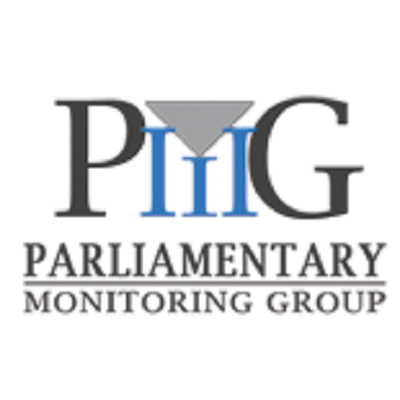Location
What is the Parliamentary Monitoring Group?
The Parliamentary Monitoring Group, an information service, was established in 1995 as a partnership between Black Sash, Human Rights Committee and Idasa with the aim of providing a type of Hansard for the proceedings of the more than fifty South African Parliamentary Committees for these three advocacy organisations. This was because there is no official record publicly available of the committee proceedings - the engine room of Parliament - and this type of information is needed by social justice organisations to lobby the Parliament of South Africa on pieces of legislation, matters of democratic processes and parliamentary oversight of the executive.
This website was set up at the beginning of 1998 to make the information generated available to a wider audience. Presently this is the only source for this type of information. We hope that the PMG committee reports and other documents will provide the public with an insight into the Parliament of South Africa and its daily activity. Importantly it provides a window into the performance of each government department and public entity over which each parliamentary committee has oversight.
PMG became a fully fledged independent NGO in July 2009.
Members:
Resources
Displaying 41 - 45 of 75Commission on Restitution of Land Rights on Strategic & Annual Performance Plan 2015/16
The Chief Land Claims Commissioner from the Commission of Restitution of Land Rights presented the strategic plan for 2015-2020 as well as the Annual Performance Plan 2015/2016 to the Committee. She emphasised that there was still a need for the Commission to be clearly delineated in function and fact from the Department of Rural Development and Land Reform (DRDLR) particularly since the Commission reported directly to the Minister.
Expropriation Bill: briefing by Minister & Deputy Minister; Public Works 2015/16 Strategic & Annual Performance Plan
With the Minister of Public Works in attendance, the Deputy Minister gave a briefing on the Expropriation Bill (B4-2015). He said that expropriation is an essential mechanism for the state to acquire property in certain instances. Section 25 of the Constitution provides that property may be expropriated only in terms of general application and to that no law may permit arbitrary deprivation of property. The Constitution states that expropriation may occur only for a public purpose or in the public interest and subject to payment of compensation.
Department of Rural Development & Land Reform, Ingonyama Trust Board, Commission on Restitution of Land Rights Strategic & Annual Performance Plans 2015/16
The Committee was briefed by the Department of Rural Development and Land Reform (DRDLR) on its Annual Performance Plan for 2015/16, with the Minister and Deputy Minister in attendance. Due to the complexity of the agrarian transformation space, the DRDLR had developed a rural economy transformation model which would be implemented through the Agrarian Transformation System.
Department of Rural Development and Land Reform & Department of Environmental Affairs on their 2013/14 Annual Reports
While the Committee was waiting for delegates from the Departments of Rural Development and Land Reform (DRDLR) and Environmental Affairs (DEA) to arrive, it had time to engage on other matters which were not on the agenda. Members were told the Committee had received a late invitation from the DRDLR to attend an indaba in Johannesburg on March 20. They agreed to seek more details on the event before deciding whether Members should attend. Minutes of the February 24 meeting were adopted without any corrections.
Ingonyama Trust Board 3rd Quarter 2014/15 Performance Report
The Committee was briefed by the Ingonyama Trust Board (ITB) on its third quarter 2014/15 performance and financial report. Apologies were received from the Minister and Deputy Minister. At the outset, Members expressed their dismay that the ITB was reporting from a document that contained different figures to the one sent through to Members earlier, and it was difficult to follow the presentation. Secondly, several commented that the reporting format was problematic, as it did not conform to standard practices nor terminology as used in the Public Finance Management Act.



